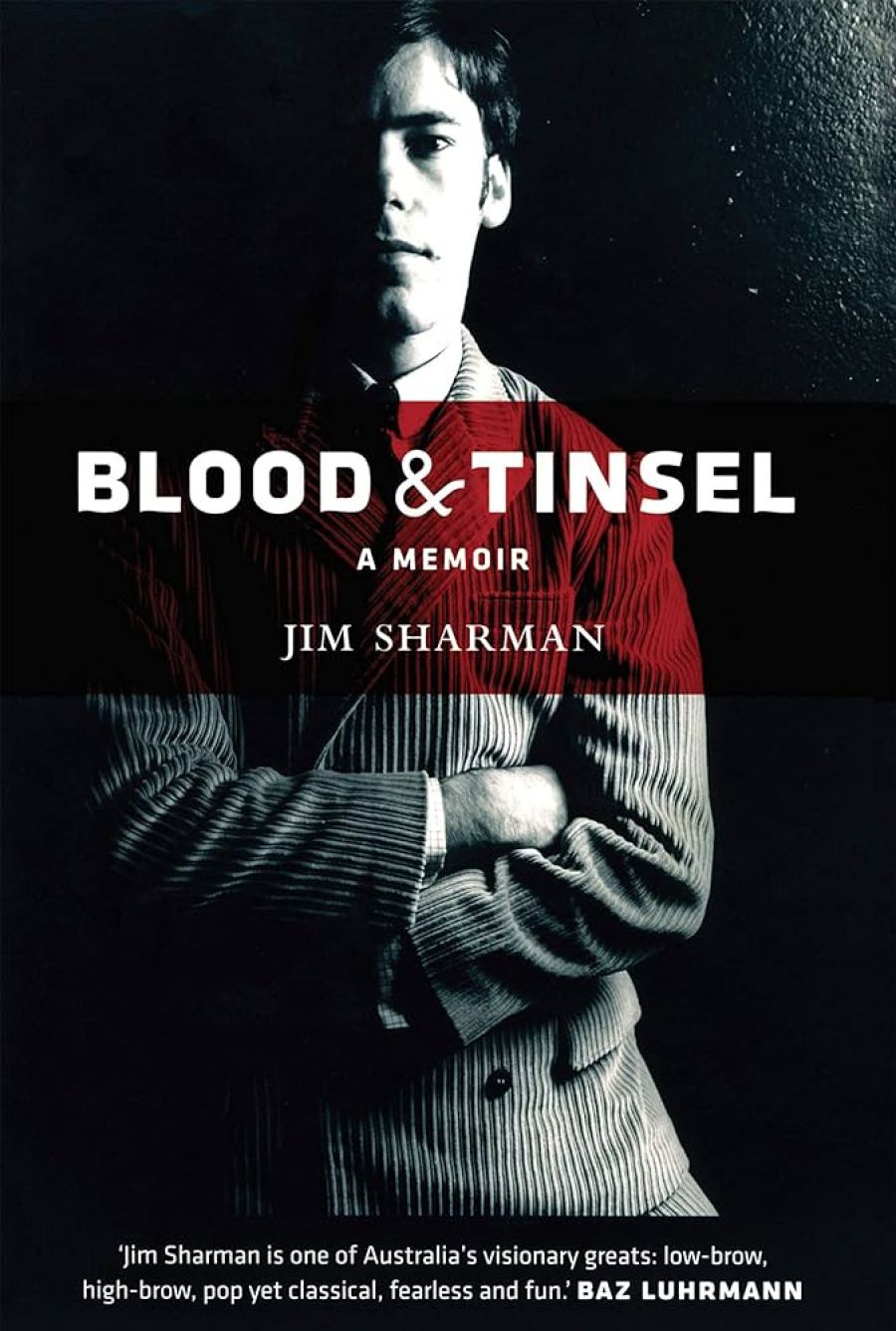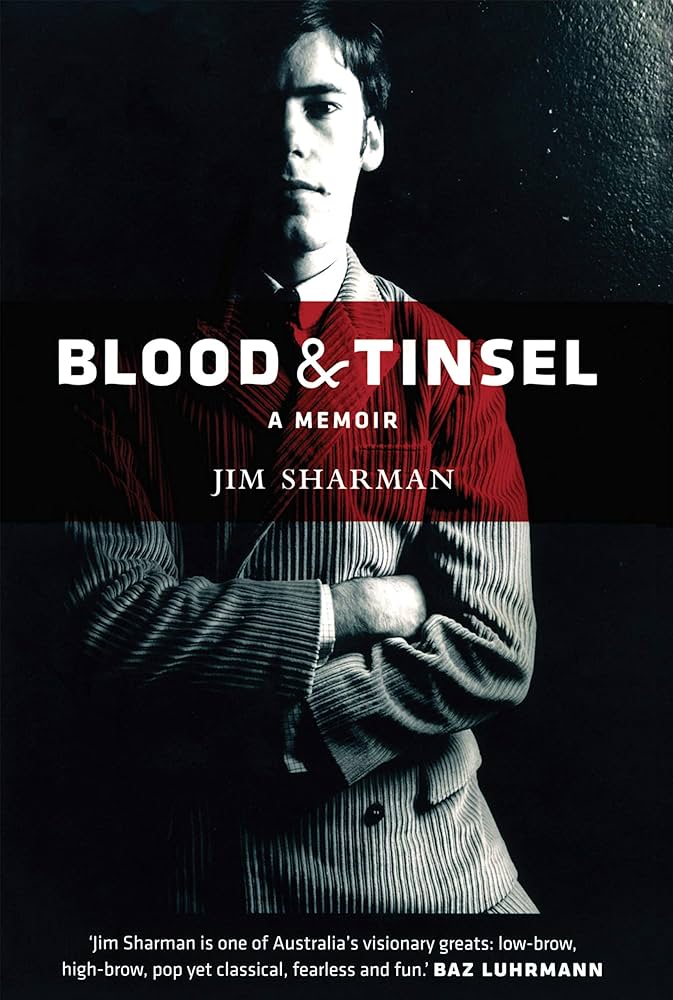
- Free Article: No
- Contents Category: Memoir
- Review Article: Yes
- Article Title: Sharman, shaman, showman
- Online Only: No
- Custom Highlight Text:
Jim Sharman and Rex Cramphorn (a future artistic director of Melbourne’s Playbox Theatre) first met at NIDA in the 1960s, and Sharman returned there as a tutor in the 1970s. He was then a ‘radical populist’, while Cramphorn was scholarly, mad about Racine and Corneille. But they agreed that theatre was a vocation, and shared a ‘crypto-mystical’ interest in the slippery relationship between reality and illusion. They would set up a short-lived theatre company at the Paris Theatre (later demolished), and mount two premières of Australian plays, Dorothy Hewett’s Pandora’s Cross (1978) and Louis Nowra’s Visions (1979).
- Book 1 Title: Blood & Tinsel
- Book 1 Subtitle: A memoir
- Book 1 Biblio: Miegunyah, $49.99 hb, 403 pp
- Book 1 Cover Small (400 x 600):

- Book 1 Cover (800 x 1200):

Cramphorn had earlier established a company called the Performance Syndicate (1969–75). Sharman reckons him to have been one of Australia’s great directors of experimental theatre. In Blood & Tinsel: A Memoir, Sharman writes that good theatre is when you emerge ‘changed from the person who parked their expectations on velvet, vinyl or upturned egg crate’. This doesn’t happen often to most of us, but when it does we can see why wildly talented people such as Sharman and Cramphorn devote their lives to it.
There is a photograph of the Paris Theatre troupe in Blood & Tinsel: twenty-five remarkable actors, designers and directors, just about all of whom have become, over thirty years, household names in Australia. Sharman, a self-described ‘bona fide alien’, has kept interesting, outrageously talented company throughout his hugely successful professional life as a theatre and opera director.
In 1995 Sharman was invited to give the first Rex Cramp-horn Lecture. Cramphorn had died of Aids in 1991, the first of many of Sharman’s friends to do so. After the funeral he found himself sobbing and understood that he had loved Cramphorn, as had many others. ‘That lecture became, in its way, the starting point for this book.’ In its way. That same year Sharman, aged fifty, fell into what he mockingly calls ‘the dip’. Anxiety, disillusionment and enveloping depression took hold of him. He had been rehearsing Genet’s Splendid’s and was about to direct a new Australian opera, The Eighth Wonder. Others took over, Neil Armfield among them. Sharman reckons that he was partly healed by Taoist poetry. At any rate, he was seduced by the idea of being healed by Taoist poetry. He went to Bali, took stock of his life, moved to an isolated house in Cairns and began to write.
Blood & Tinsel is a great big can of very big fish. At the age of twenty-two, Sharman directed Don Giovanni (‘a character who is both a vacuum and a force of nature’) for the Elizabethan Theatre Trust. Two years later, in 1969, he directed Hair for Harry M. Miller; productions in Tokyo and Boston followed in 1971. In 1972 Sharman directed Jesus Christ Superstar in Sydney and London. The Rocky Horror Show arrived in 1973 and stayed forever (more than one million people saw it in Sydney alone). Sharman became, in other words, through vocational tenacity, profound intelligence and open-mindedness, the professional he had hinted to his parents, at the age of fourteen, that he wanted to be: not to be a performer but someone who ‘imagined it up’.
The Sharmans were no ordinary family. The opening section of this big, inclusive, personal and ultimately generous book is a marvellous record of the author’s legendary grandfather Jimmy Sharman and his boxing troupe; of his own father, Jim Sharman, a second-generation ‘showie’; of showgrounds and sideshow alleys’ of ‘change-room sexuality ... fuelled by linseed oil, sweat, sawdust, towels, jockstraps, humidity and flesh’. Jim Sharman the third – an only child (though he later finds out he has a brother), observer of illusion and impermanence – seems to have had only one career ahead of him.
Sharman’s record of this career often seems to be the glossy sum of meetings with the famous, and edges towards what might be called ‘tales out of school’. When I came to his account of Rudolf Nureyev’s notorious sexual jaunts in Sydney (I cannot find this now, there is no index), I had just finished reading a review of Lionel Davidson’s biography of Nureyev, in which an incident involving the dancer, broken glasses and a plate of spaghetti is related by Nureyev to his biographer, ‘as if to clear up one of the great issues of our time’, Davidson writes. This is the problem with meetings that seem meaningful to the writer but strike the reader as merely gossipy. But Sharman does more with other meetings. He exchanged a look with Andy Warhol at The Factory in the late 1960s: a gaze that was ‘part seductive, part forensic, part blank’. That look of ‘naked desire’ was to be experienced again only a few times: in London, with the painter Francis Bacon, in Germany with the choreographer Pina Bausch (whom he would bring to Australia in 1982) and in Sydney with Patrick White.
I would get to meet and know Patrick, and through him I would come to better understand what that look meant. It was a look of shared recognition that seemed exclusively the province of carnivorous artists or monstres sacrés. The look of impossible love shared between predatory vivisectors.
If there is a heart to Sharman’s book, it is his professional and personal relationship with White, who appears as early as page six (White was born in 1912, as was Jim’s father) and whose last line from The Tree of Man (1955) is reproduced on the last page of Blood & Tinsel. White adored Sharman and showered him with books and phone calls (‘I had released Patrick’s backstage genie. It had been dormant too long. He wanted showbiz; I wanted art house’). Sharman believed in White as dramatist as well as novelist: ‘the sprawling Mahler symphony of Riders in the Chariot – his finest novel I always thought – the cello concerto of The Eye of the Storm ... he knew and revealed how power and history colluded in Australian society, and to exactly what end.’
From The Season at Sarsaparilla in 1976 to A Cheery Soul in 1979, with its great performance by Robyn Nevin, to the opera made of Voss in 1986, with music by one of Sharman’s earliest mentors, Richard Meale, and libretto by David Malouf, White remained central to Sharman, ‘the mentor I was seeking’. He writes of White that he ‘viewed ordinariness with a reverence others save for sacred sites’.
Sharman directed Stephen Sewell’s Three Furies in 2005 and Benjamin Britten’s opera Death in Venice the next year, with sets by Brian Thomson, who had been there in the Paris Theatre days. Theatre, of all the arts, seems to forge the most enduring artistic links. Next year, forty-two years after that controversial Don Giovanni, Sharman will direct Così fan tutte for Opera Australia. Mozart, Mahler and Messiaen were the composers he listened to when he was living alone in Cairns. What a remarkable life and talent, and, for all that it is sometimes difficult to follow, what a frank, engaging history Blood & Tinsel is, enigmatic variations on the central theme of theatre by a ‘Sharman, Shaman, Showman’.
This reviewer had one short, formal brush with the enigmatic Sharman. Having directed the 1982 Adelaide Festival, he was on the board for both of Robyn Archer’s festivals, and he was still there when the American opera and festival director Peter Sellars was appointed artistic director for the 2002 one. Sellars chose to work through Australians, a decision that, judging by what he has written in Blood & Tinsel, would have had Sharman’s approval, if not that of the other board members. Working with Sellars and seven other associate directors, I remember several confronting meetings with the board at which people did not say what they really thought and at which Sharman said little. Sellars was run out of town through the machinations of media and management. It was to have been a radically different festival, but a self-serving, peculiarly Adelaidian conservative conspiracy undermined Sellars’s vision (though I agree with Sharman that Sellars ‘could be the architect of his own problems’). Sharman resigned in protest over Sellars’s ‘resignation’. He was the only one to show any comprehension, any spunk.

Comments powered by CComment